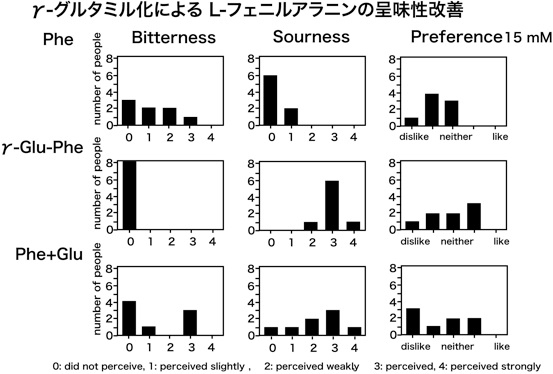1-5-2-3.転移反応の応用例
ここでは、γ-グルタミル化による苦味アミノ酸の呈味性改善についてのみ、詳しく説明します。
いくつかのL-アミノ酸は苦味を呈します。分枝鎖アミノ酸、芳香族アミノ酸、塩基性アミノ酸などです。残念なことにこれらの多くは必須アミノ酸です。そのためアミノ酸混合物を経口摂取する場合、これらのアミノ酸の苦味が重大な問題となります。ここにあげた例は、Pheとγ-Glu-Pheの呈味性試験の結果です。縦軸は人数。横軸は味をどのくらいの強さで感じるか、あるいは嗜好性を5段階評価で示しています。15 mMでは、ほとんどのパネルメンバーはPheを苦いと感じました。しかし全員γ-Glu-Pheは苦くないと感じました。γ-Glu-Pheは強い酸味を示しましたが、この酸味はレモンのような爽やかな酸味であったため、Pheに比べて嗜好性が改善しました。
グルタミン酸をフェニルアラニンに単に加えただけでは、酸味は増すものの、この苦味と嗜好性の改善は得られず、苦味低減のためにはγ-グルタミル結合していることが必要です。

参考文献
H. Suzuki, C. Yamada, and K. Kato. γ-Glutamyl compounds and their enzymatic production using bacterial γ-glutamyltranspeptidase. Amino Acids, 32(3), 333-340 (2007).
H. Suzuki, H. Minami, S. Izuka, N. Miyakawa, Y. Kajimoto, K. Kato, S. Ishihara, and H. Kumagai. Effective use of bacterial γ-glutamyltranspeptidase to improve the taste of food. In State-of-the-Art in Flavour Chemistry and Biology. Ed. by T. Hofmann, M. Rothe, and P. Schieberle, Deutsche Forschungsanstalt fur Lebensmittelchemie, pp. 205-212 (2005).
H. Suzuki, K. Kato, and H. Kumagai. Enzymatic synthesis of γ-glutamylvaline to improve the bitter taste of valine. Journal of Agricultural and Food Chemistry,52(3), 577-580 (2004).
H. Suzuki, and H. Kumagai. Application of bacterial γ-glutamyltranspeptidase to improve the taste of food. In Challenges in Taste Chemistry and Biology. Ed. by T. Hofmann, W. Pickenhagen, and C.-T. Ho., American Chemical Society, Washington, D.C., p. 223-237 (2004).
H. Suzuki, Y. Kajimoto, and H. Kumagai. Improvement of the bitter taste of amino acids through the transpeptidation reaction of bacterial γ-glutamyltranspeptidase. Journal of Agricultural and Food Chemistry, 50(2), 313-318 (2002).
